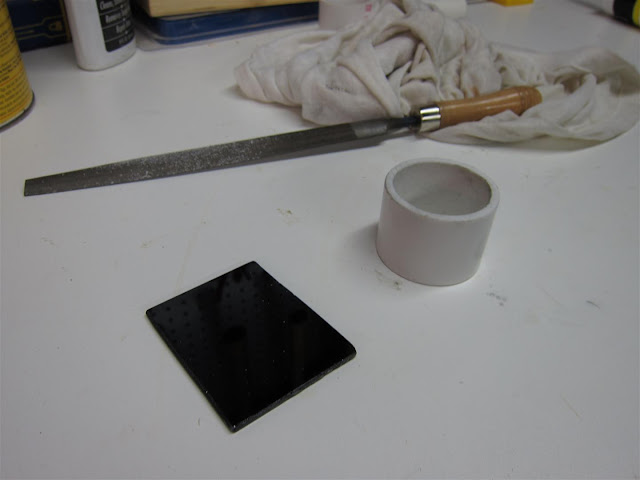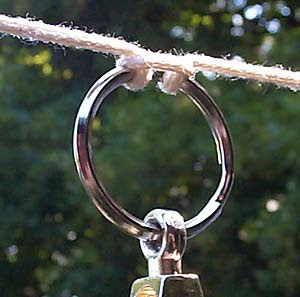12/17/2011
12/12/2011
Signature to Photos
I decided that i should put my name and the date on some of the photos i upload to the blog. The way that i did it was to sign a piece of paper about fifty times. (not the actual way i sign my name for important documents though)
Then i scanned that paper and decided what signature i liked the best and isolated it. In Photoshop i fixed any out of place pixels and upped the contrast so there was only black and white.
Then i used the dreaded magic want tool, selected the background and deleted it. That way the signature would be transparent instead of always having a white background. Here is what it looked like when i was done. If the photo is dark where i want to put the signature then after pasting it in i just select "invert colors" and the signature will be white or gray.
If the photo is dark where i want to put the signature then after pasting it in i just select "invert colors" and the signature will be white or gray. 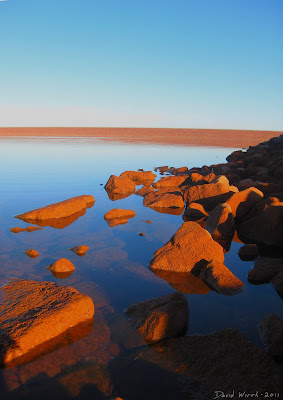
Then i scanned that paper and decided what signature i liked the best and isolated it. In Photoshop i fixed any out of place pixels and upped the contrast so there was only black and white.
Then i used the dreaded magic want tool, selected the background and deleted it. That way the signature would be transparent instead of always having a white background. Here is what it looked like when i was done.
 If the photo is dark where i want to put the signature then after pasting it in i just select "invert colors" and the signature will be white or gray.
If the photo is dark where i want to put the signature then after pasting it in i just select "invert colors" and the signature will be white or gray. 
12/11/2011
Welders Glass ND Filter
I was reading online about a cheap alternative to a Neutral Density (ND) filter to use for photography. An ND filter is basically sunglasses for your camera. It decreases the amount of light that gets through, thus allowing you to keep the lens open longer. Neutral density filters can cost as much as $400 for a really nice one.

And make a type of "dark housing" to fit over the camera lens. I used a piece of PVC pipe and a permanent marker to color it black.
Then glued it together.
I used a rubber band to hold it onto the camera and some cloth on the edge so it wouldn't scratch anything.

The two main problems with using the welders glass is that it is not as high a quality as an ND filter and that it has a green tint. This is what the image looks like right out of the camera. This was a 64 second exposure during the day.
But in Photoshop this can be corrected, mainly by adjusting White Balance and Tint.
That design was not the best, it was too big and heavy. So i tried to simplify it.
I started with the same 2" square piece of glass that i cut from the larger glass. But then i used pliers as a kind of glass nippers and slowly broke off corners until it was round.

I sanded and filed the sharp edge. Then just as before i glued it to a PVC pipe i colored black, inside and out. But the key difference is this time is that i glued a foam ring to the inside of the PVC.


I sanded the foam down until i could slide it onto the outer lens, but with just enough pressure that it wouldn't fall off.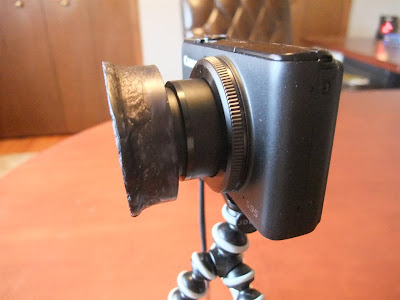

I plan to use it when i'm in Tennessee to take pictures of some waterfalls.
The cheap alternative is to use a welders glass. They type of glass that welders for eye protection against the bright light created during welding. So i went to Lowe's and bought one.

And make a type of "dark housing" to fit over the camera lens. I used a piece of PVC pipe and a permanent marker to color it black.
Then glued it together.
I used a rubber band to hold it onto the camera and some cloth on the edge so it wouldn't scratch anything.

The two main problems with using the welders glass is that it is not as high a quality as an ND filter and that it has a green tint. This is what the image looks like right out of the camera. This was a 64 second exposure during the day.
But in Photoshop this can be corrected, mainly by adjusting White Balance and Tint.
That design was not the best, it was too big and heavy. So i tried to simplify it.
I started with the same 2" square piece of glass that i cut from the larger glass. But then i used pliers as a kind of glass nippers and slowly broke off corners until it was round.

I sanded and filed the sharp edge. Then just as before i glued it to a PVC pipe i colored black, inside and out. But the key difference is this time is that i glued a foam ring to the inside of the PVC.


I sanded the foam down until i could slide it onto the outer lens, but with just enough pressure that it wouldn't fall off.


I plan to use it when i'm in Tennessee to take pictures of some waterfalls.
11/30/2011
Canon S95
It was time to replace my trusty Canon SD770IS. I wanted another Canon camera for a couple of reasons: they have great battery life, well made, but most importantly i could continue to use the CHDK program.
I still wasn't sure whether i should get a new camera that cost around $200 or buy a cheap used one for around $80. I thought about getting a used Canon PowerShot A580. New they cost around $180, but i could not find a used one.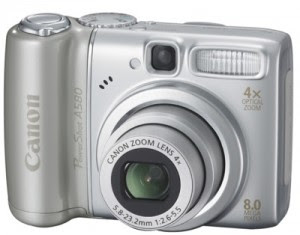
As far as new camera's i looked at getting the Powershot ELPH 300 HS, it was recently on sale for $160. That bad part is that they haven't written the CHDK program for that specific model. Maybe they will in the future but i decided not to get it right now.
I had seen and read about the Canon S95 for a while now. Every magazine review says it's the best point and shoot camera there is. The downside is that it cost $400. But after Thanksgiving it went on sale for $290.
It was the closest thing to what i wanted, a DSLR that's not $1000 and fits in my pocket. So i bought it.
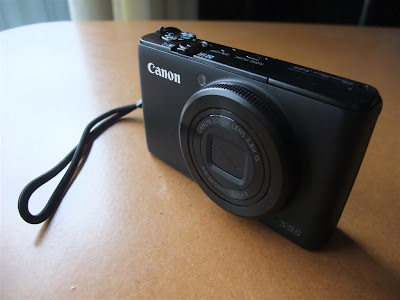
Here's what the CHDK program menu looks like on the camera.
I also bought a leather case that attaches to the camera. It's a little awkward to take pictures while the case is attached.

But i do like it when it is completely covered.

I still might get a cheap used Canon for the more "risky" type of pictures, like tying it to a kite.
I still wasn't sure whether i should get a new camera that cost around $200 or buy a cheap used one for around $80. I thought about getting a used Canon PowerShot A580. New they cost around $180, but i could not find a used one.

As far as new camera's i looked at getting the Powershot ELPH 300 HS, it was recently on sale for $160. That bad part is that they haven't written the CHDK program for that specific model. Maybe they will in the future but i decided not to get it right now.

I had seen and read about the Canon S95 for a while now. Every magazine review says it's the best point and shoot camera there is. The downside is that it cost $400. But after Thanksgiving it went on sale for $290.
It was the closest thing to what i wanted, a DSLR that's not $1000 and fits in my pocket. So i bought it.

Here's what the CHDK program menu looks like on the camera.

I also bought a leather case that attaches to the camera. It's a little awkward to take pictures while the case is attached.

But i do like it when it is completely covered.

I still might get a cheap used Canon for the more "risky" type of pictures, like tying it to a kite.
Star Pictures
Before i crashed the kite and broke the camera i took these pictures of stars from the roof of my garage. They were 50 seconds exposures (which was a bit too long, 30 or 40 would have been better) and this time i did not use the dark frame subtraction so there wasn't a 50 second wait time in between each picture. Although there was some dark patches in the pictures, probably due to the lens.
Again this was done by combining several pictures that were taken over about an hour. Half way through some clouds blew in and screwed it up a bit. Here's the original, untouched picture taken over the first 30 minutes.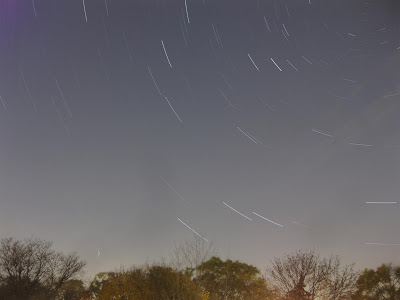
Here's the other original picture over the entire hour.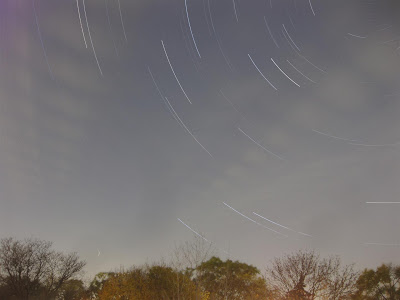
I Photoshopped them look better.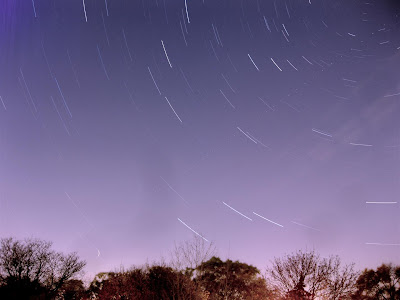
I just randomly pointed the camera toward the sky, you can see that i almost got the North Star in the upper right hand corner.
This one i used a purple lens filter effect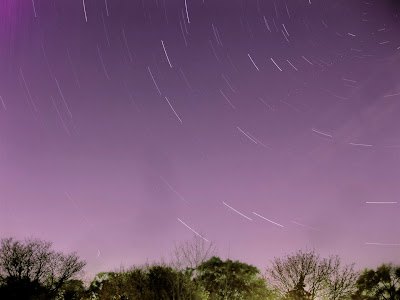
For better results i need to use a better camera, on a night with no clouds and in an area out in the country where the stars are really bright.
Again this was done by combining several pictures that were taken over about an hour. Half way through some clouds blew in and screwed it up a bit. Here's the original, untouched picture taken over the first 30 minutes.

Here's the other original picture over the entire hour.

I Photoshopped them look better.

I just randomly pointed the camera toward the sky, you can see that i almost got the North Star in the upper right hand corner.
This one i used a purple lens filter effect

For better results i need to use a better camera, on a night with no clouds and in an area out in the country where the stars are really bright.

Backyard Pond
I thought it would be a cool idea to make a pond in my backyard. Next summer i could plant the lotuses and lily-pads, maybe add some goldfish too.
Here's the area i planned on putting the pond. It would be 'L' shaped and fit in between the wood fence and the concrete slab.
I dug down about 4" the approximate area of the pond. I removed the topsoil, leaving the clay.
Then in Photoshop I drew in what i thought the pond might look like. I added water, rocks, lotuses and a tiny waterfall in the corner. The waterfall would help aerate the pond and i would also filter the water using a homemade first flush filter.

Here's the area i planned on putting the pond. It would be 'L' shaped and fit in between the wood fence and the concrete slab.

I dug down about 4" the approximate area of the pond. I removed the topsoil, leaving the clay.

Then in Photoshop I drew in what i thought the pond might look like. I added water, rocks, lotuses and a tiny waterfall in the corner. The waterfall would help aerate the pond and i would also filter the water using a homemade first flush filter.


Final Flight
After getting the flowform kite to fly with the camera i was almost ready for my homemade kite to give it a try. Here's the link from the earlier kite making.
I did the last bit of finishing touches to the kite, mainly the bridle. Then i had to make a better, steadier, harness for the camera. The thing to use is called a picavet. It is a harness and bracket that ensures that the camera is always level, no matter what angle the string is at.

This time i was in the park down the street.
That's 15 mile road at the top.



Notice the sidewalk down there...
Well i guess the saying is "you can't make an omelet without cracking some eggs."

Just as i started pulling the kite in the string snapped and it fell to the only area of pavement, of course, the bike path. The problem was that the washers used had too sharp of edges and after 20 minutes the kite string snapped.
The kite floated away, even after an hour of looking for it i never saw it again. I'm pretty sure it landed in someones backyard on the other side of the woods.
Since the camera was totally broken i decided to just take it apart and see how it's made.
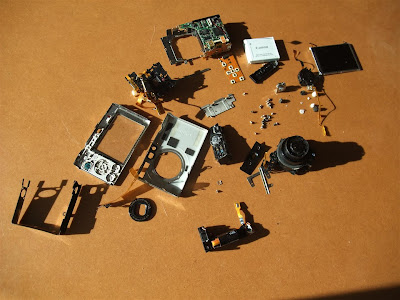
I plan on getting another used or new Canon camera and making another flow-form kite. It's a bummer, but i've needed a different camera for a while. That one had so many things wrong with it:
I did the last bit of finishing touches to the kite, mainly the bridle. Then i had to make a better, steadier, harness for the camera. The thing to use is called a picavet. It is a harness and bracket that ensures that the camera is always level, no matter what angle the string is at.

Someone online said that they attach it to the kite string using a simple metal o-ring. It loops over the line and seemed like a good idea. I didn't have an o-ring so i used copper washers.
I first tried the Rokkaku kite, but it was way too windy and it didn't fly at all. The kite kept zig-zagging back and forth. So i used the flow-form kite that flew before when the wind was really blowing hard.
Again it went right up with the camera. 
This time i was in the park down the street.

That's 15 mile road at the top.



Notice the sidewalk down there...

Well i guess the saying is "you can't make an omelet without cracking some eggs."

Just as i started pulling the kite in the string snapped and it fell to the only area of pavement, of course, the bike path. The problem was that the washers used had too sharp of edges and after 20 minutes the kite string snapped.
The kite floated away, even after an hour of looking for it i never saw it again. I'm pretty sure it landed in someones backyard on the other side of the woods.
Since the camera was totally broken i decided to just take it apart and see how it's made.


I plan on getting another used or new Canon camera and making another flow-form kite. It's a bummer, but i've needed a different camera for a while. That one had so many things wrong with it:
- broken battery door
- dirt inside lens
- missing lens cover
PhotoFly 3D_30
I read in a magazine about Autodesk Photofly 2.0. It's a free program from the same company that does AutoCAD, which is the software that i use at work.
The way it works is that you take lots of pictures of something from all different angles, then upload it to Autodesk and it creates a 3D image.
The hard part is taking all the pictures. The easy part is that once you are done you just upload them and the program does the rest. Well sort of, the first time i tried it, it said that i didn't have enough images to create a 3D image. And the program crashes a lot.
My first try was an old fishing reel. I took about 40 pictures, but apparently that wasn't enough.
The next try i took a bunch of pictures of the clay ocarina i made. It didn't come out right but at least it sort of worked.
Here's "part" of my car in the driveway.
The way it works is that you take lots of pictures of something from all different angles, then upload it to Autodesk and it creates a 3D image.
The hard part is taking all the pictures. The easy part is that once you are done you just upload them and the program does the rest. Well sort of, the first time i tried it, it said that i didn't have enough images to create a 3D image. And the program crashes a lot.
My first try was an old fishing reel. I took about 40 pictures, but apparently that wasn't enough.
The next try i took a bunch of pictures of the clay ocarina i made. It didn't come out right but at least it sort of worked.
Here's "part" of my car in the driveway.
Obviously it's not perfect but it's still kind of cool.
11/16/2011
Moneyball
Karrie and i saw Moneyball the other night. It was a great movie.
It's based on the true story of the Oakland Athletics trying to compete in baseball with only a fraction of the payroll of teams like the New York Yankees.
Brad Pitt was the general manager that realized that he could not compete by doing the same thing the other teams were doing.

Jonah Hill played the guy that majored in economics and calculated the players with the most value.

It showed cool inside meetings of how players were traded to different teams.

It was a little slow at times but overall really interesting and funny.

It's based on the true story of the Oakland Athletics trying to compete in baseball with only a fraction of the payroll of teams like the New York Yankees.
Brad Pitt was the general manager that realized that he could not compete by doing the same thing the other teams were doing.

Jonah Hill played the guy that majored in economics and calculated the players with the most value.

It showed cool inside meetings of how players were traded to different teams.

It was a little slow at times but overall really interesting and funny.

Subscribe to:
Comments (Atom)







